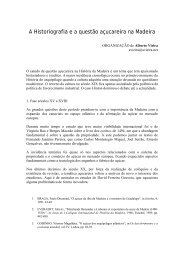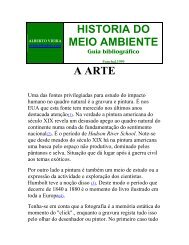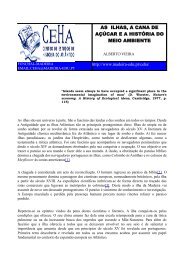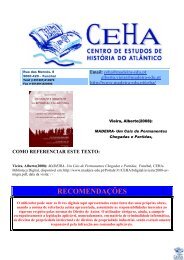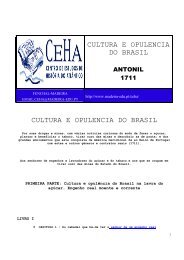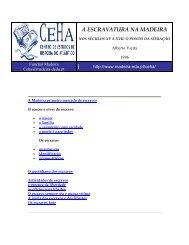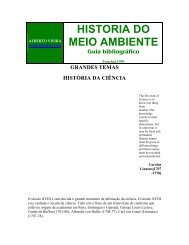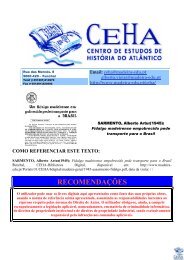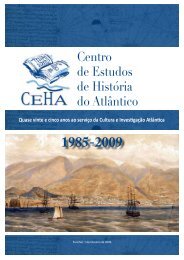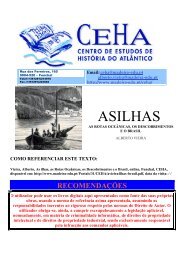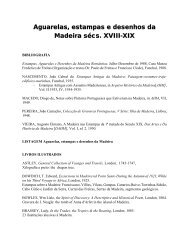SLAVERY IN MADEIRA
SLAVERY IN MADEIRA
SLAVERY IN MADEIRA
Create successful ePaper yourself
Turn your PDF publications into a flip-book with our unique Google optimized e-Paper software.
the skin, and certainly the remote slavish condition, to the second this characteristic was<br />
associated the new social status. In the case of the emancipated one can add, with<br />
assiduity, the name of the ex-owner, giving it this way a mark of the previous condition.<br />
In all the documents only 365 freedmen (5,4%) are referred, and 270 free coloureds (4%).<br />
In both cases, the majority are Negroes.<br />
The slaves were always a matter of concern for the free men. Manuel Damil is positive in<br />
relation to the liberation of the slaves: "it is misadventure because as he has no support of<br />
the lord he will get lost". To confirm this idea, Manuel Damil refers that "all the liberated<br />
in this land will be done...from the tavern or the chain will not escape". And he was not<br />
mistaken! since the seventies of the XVI-century restrictive measures were taken in<br />
relation to the liberated in Madeira, which resulted certainly from the difficulties they<br />
caused in society.<br />
The solidarity bondage that linked this group to the slaves, the easy social contact with<br />
criminals and malefactors drove the established society to consider them a risk group.<br />
Their presence was always a reason for concern, and the houses they lived in were, in the<br />
understanding of the by-laws of 1546, "dens of thieves".<br />
It was also common for the emancipated and even the slaves to associate themselves to<br />
the workers that came from the kingdom, who lived on wages. As a result, many female<br />
slaves who had social contact with them robbed their lords as a way to collect money for<br />
liberation fee. Others still, robbed the owners on products that would then be sold in the<br />
market, as a way of saving enough money to reach freedom.<br />
In accordance with this we might come to the conclusion that life for the freedmen was<br />
difficult, and that society and laws, together with a fragile economic situation,<br />
contributed for a tormented daily living. This way, the position of the freedmen was not<br />
easier than the one of the slave. The slave had to work and be subjected to the owner, but,<br />
as a compensation he would give him lodging, food and protection; after liberation, all<br />
depended on himself and on the intervention capacity of society. He would still have to<br />
take into account the segregation imposed by it and the obligations of the charges<br />
imposed by the ex-owner.<br />
The number of freedmen in Madeiran society developed according to the economic<br />
conjuncture and specific conditions of slavery. Here, it seems necessary to establish a<br />
distinction between the ones that are labelled by the quality of the emancipated, and the<br />
others only free, but due to their race it seems to us that they were also slaves. For the<br />
period between 1471 and 1700 we are faced with 590 freedmen and 164 free, defined as<br />
coloureds, Negroes or Moors. The freedmen are in its majority adults (87%) and female<br />
(55%).<br />
The geographical expression meets the slavery spot of the archipelago, having the Se<br />
parish as dominant, with 68% of the total of freedmen. If we add the other parishes in the<br />
urban area, the number will go up to 72%. Out of this space, we have the parishes of




